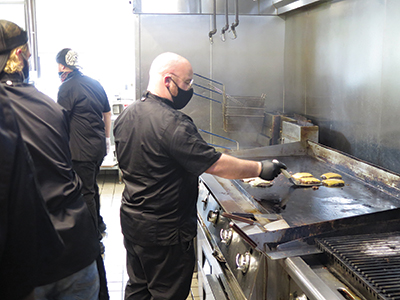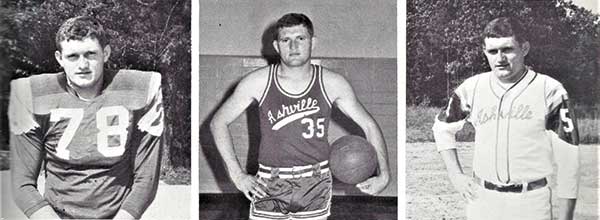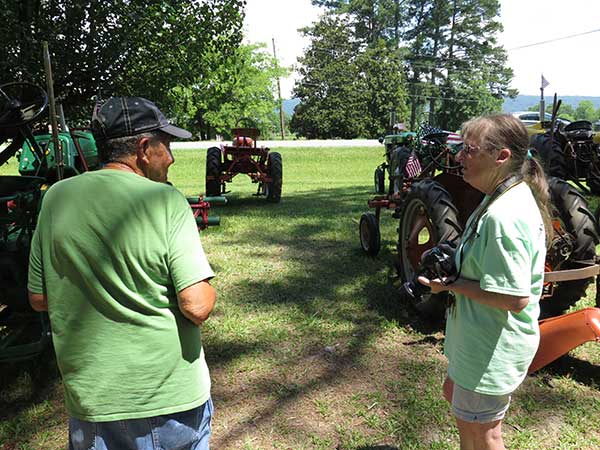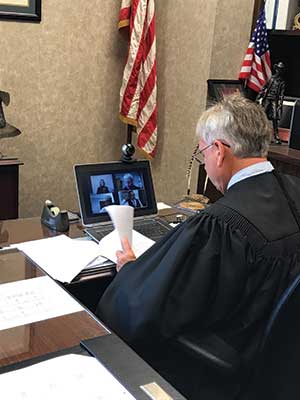Springville-bred food artist finds home in Birmingham’s noted culinary scene
Story by Scottie Vickery
Photos by Graham Hadley
Submitted Photos
Cory Bolton had barely started walking when his grandmother plopped him on the kitchen counter with a spoon and a mixing bowl full of corn meal. It was an easy way to keep the toddler entertained while she cooked, so she told him he was helping.
It turns out those early days in the kitchen with his grandmother, Sandra Bolton, were much more than a diversion. They were the first cooking lessons Cory, who grew up in Springville and is now the executive chef at Fancy’s on 5th in Avondale, ever had.
“I remember it like it was yesterday,” he said. “She made biscuits pretty much every day, and she’d put me on the counter with this big green glass bowl. By the time I was three or four, I was kneading the dough, and she would teach me as she went. That really set into motion for me a lifetime of enjoying food.”
These days, the 32-year-old Bolton is giving guests at Fancy’s on 5th plenty of food to enjoy themselves. The restaurant, which bills itself as an oyster dive and burger bar, offers everything from seared ahi tuna and oysters served with golden kiwi strawberry mignonette to a fried flounder BLT, grilled octopus tacos, and a burger featuring chipotle aioli, pico de gallo, fried jalapenos and pepper jack cheese.
“I cook a little bit of everything, but my specialty is definitely seafood – Southern-style food and seafood,” he said. “I’ve cut about every fish in the Gulf of Mexico.”
Home cooking
Cory has been at a number of restaurants in Birmingham and Tuscaloosa over the years, working his way up from dishwasher to cook to sous-chef to head chef to the co-star in an online cooking show. His start in the restaurant business, though, came close to home when his parents, Mike and Beth Bolton, opened Big Bolton’s BBQ in Argo in 2009. Cory, 21 at the time, helped them run the place.

Mike, who had just retired after 25 years as an outdoor writer and columnist for The Birmingham News, definitely knew his way around a grill and a smoker. “The men in my family like to cook meat, smoke meat,” Cory said. “Dad was always doing the hunting and fishing stuff – cooking Boston butts or brisket at the hunting camp.”
Mike, the author of several books, including Preparing and Cooking Alabama’s Wild Game, is quick to declare his son the expert. “He’s a much better cook than I am,” Mike said. “I was pretty simple, but he was always trying different things. He came up with a marinade for grilled chicken that was incredible. People just loved it.”
After moving Big Bolton’s to a new location in Springville, the family closed the restaurant in 2011 during the economic downturn. “I tell people that saying, ‘You can cook good, you ought to open a restaurant’ is a lot like saying, ‘You put your seatbelt on good, you ought to be a NASCAR driver,’” said Mike, now the editor of Alabama Outdoor News and the owner of Victory Lane Catering.
While the experience led Mike to say “never again” to the restaurant business, the disappointment inspired Cory to work even harder to achieve his dream. “I’m definitely a person who, if I get knocked down, I’m going to get back up,” he said. “If Big Bolton’s goes out of business, then I’m going to show everyone that I can be a chef.”
He’s drawn on his St. Clair County upbringing throughout his career. Cory was especially involved in extracurricular activities and sports at Springville High School, and the lessons he learned on the field have helped him in his career.
“All of the team-building stuff, I use it every day,” said Cory, who was captain of the football team and helped with coaching after high school. “Trying to get an 18-year-old kid to focus, and not text girls, is a lot like a chef trying to get guys to focus intently for six hours. Sports taught me to lead a team and be part of a team.”

Growing up, Cory traveled to barbecue competitions, Bassmaster Classics, and trade shows with his father, and he got early exposure to some of the more exotic foods. “I’m eating rattlesnake, fried crappie, squirrel soup and all this crazy food most kids don’t get to experience,” he said.
At church, he found more than a spiritual foundation. His parents were the kitchen managers at Clearbranch United Methodist Church for about 12 years, and Cory and his sister, Lauren, could often be found helping with spaghetti dinners and other events. “Even as a 12-year-old, I’m learning how to use industrial kitchen equipment at my church,” he said. “I never knew I was in training.”
The real foundation, though, was set at the nearby Trussville home of his grandparents, Sandra and Clyde Bolton. “I have four grandchildren, and Cory is the only boy,” Sandra said. “The girls didn’t care much about being in the kitchen, but Cory always was. I’ve always had a love for cooking, and Cory is like me on that. It’s not work for us, it’s fun.”
Pursuing his dreams
Despite his love of cooking, Cory is self-taught and never attended culinary school. As a student at Jacksonville State University and Jefferson State Community College, he envisioned a career in public relations, or as a journalist or sports information director. The kitchen, however, kept calling his name.
He worked in a number of places over the years, including food trucks and Primeaux Cheese & Vino in Birmingham, and he enjoyed a stint as head chef at a sushi restaurant. His years at the award-winning Ocean, in Birmingham’s Five Points district, shaped him the most, however.
“That was a real turning point for me because I had a real mentor,” Cory said of the restaurant’s owner, George Reis. “George is a real live chef – intense, not accepting less than perfection. He helped me develop my cooking for sure, but he taught me how to be a chef.”
Reis allowed Bolton to change the menu and add his own flair to dishes, and he also taught him to trust himself in the kitchen. “He let me come into my own as a chef, and I really understood what we were doing,” said Cory, who also worked for Ocean’s sister restaurant, 26. “I didn’t have to read the music, I could just play by ear.”

That instinct is what makes him stand out from the crowd, Mike said. “Cory really gets that cooking is about 25 percent cooking and 75 percent science,” he said. “He’s really good at that.”
It’s something that came naturally, even as a child helping his father grill, Cory said. “Good barbecue is good but without great sauce, it’s just good barbecue,” he said. “The sauce has to have the right amount of sweet, spice and acidity. Good sauce isn’t just sweet or just spicy or just tangy, it’s a balance of all those things. At 10 years old, if you’re understanding the balance of flavors, you’re really understanding the science of cooking.”
He got to experiment a little in the three years he was executive chef at River in Tuscaloosa before moving back to Birmingham to be closer to home and family. Bolton’s friend and fellow chef Addison Porter followed him to River, and the duo got creative with steaks, seafood and dishes like pork rinds and queso cheese with black-eyed pea relish. “We were doing some really great stuff, complicated food,” Cory said. “It was crazy busy. After an Alabama-LSU game, you’re serving 500, 600 people.”
While at River, Cory and Addison started filming “Chunks,” a cooking show for Allrecipes.com, a food-focused social network featuring recipes, how-to videos and inspiration. They filmed four episodes before the pandemic, and Cory hopes to eventually do more. They made some over-the-top creations for the show, including a 10-pound egg roll stuffed with gameday foods, including burgers, buffalo chicken, chips and salsa.
“We are kind of flamboyant, crazy people, and we’ve had a lot of fun,” Cory said. “We’ve worked in the kitchen together for about seven years and everyone says we speak a different language. One of us will just point, and the other one knows exactly what he wants.”
That rapport comes in handy with Cory’s latest mission of doing the impossible and making his grandmother’s fried chicken recipe even better. “Fried chicken is my favorite food ever,” Cory said. “My ultimate goal is to open a fried chicken restaurant and let Addison run it.”
Green onion and a specially seasoned flour are the secret ingredients in Sandra’s recipe, and Cory and Addison have experimented with additional spices and seasonings. “We started with everything we loved about her recipe and have been adding different things and trying to perfect it,” Cory said. “We’ve worked on it, and I’m not kidding, for five years like mad scientists.”
So, what does Sandra think about his lofty goal? “I don’t know if I can even take it to her,” Cory said with a laugh. “If she knew I changed her recipe, I might not be able to go to Thanksgiving.”
He’s not really worried, though. While he loves being the “crazy, city boy chef,” Cory acknowledges his grandmother always welcomes him with open arms, and she’ll always be the best cook he knows. “You can take a recipe you loved as a child, add high level techniques and skill, but it’s still never going to be what your grandmother cooked,” he said.
For more, visit Fancy’s on Fifth’s website
or follow them on Facebook





























